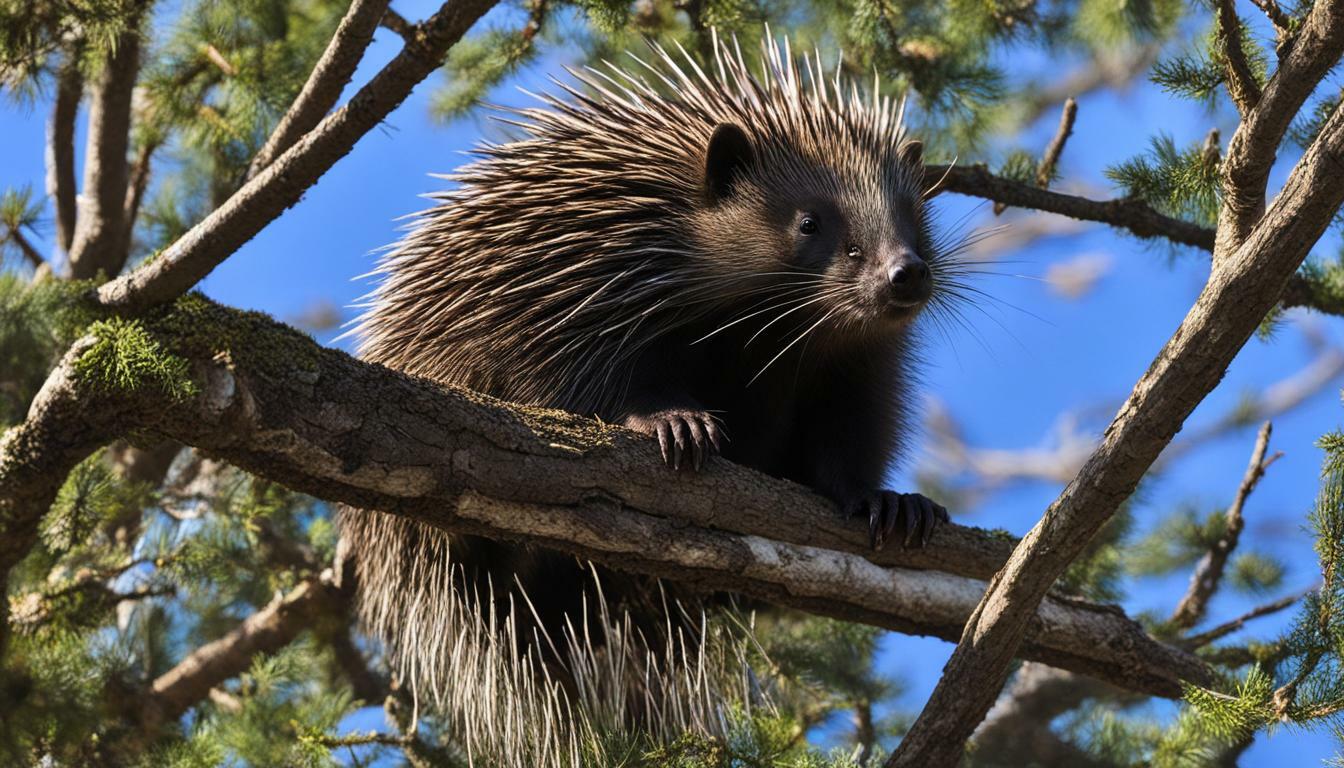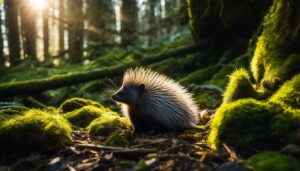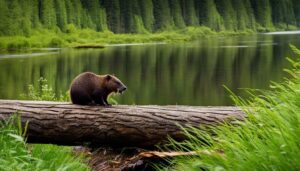Porcupines are skilled climbers and can climb trees using their front and back claws to grasp the wood as they pull themselves upward. These fascinating creatures often venture into the upper canopy of trees during the daytime for various purposes, such as eating and resting. While they have quills that serve as a defense mechanism, porcupines do not shoot or throw them at predators. Instead, the quills stick into predators and are dislodged when the predator retreats.
Found in forests in the northern and western regions of the United States and Canada, porcupines are herbivores that feed on a variety of plant materials. Their diet includes fruits, tender twigs, leaves, conifer needles, and bark. While their climbing abilities are impressive, porcupines can sometimes cause harm to trees by stripping off bark, which exposes the trees to potential disease.
It’s worth noting that porcupines have a peculiar taste for salt and may chew on wooden objects like tool handles and paddles. This behavior, although puzzling, adds to their unique characteristics.
Key Takeaways:
- Porcupines are skilled climbers, capable of ascending trees using their front and back claws.
- They often move into the upper canopy of trees during the daytime for various activities.
- Porcupines have quills as a defense mechanism, with the quills sticking into predators upon contact.
- These creatures are found in forests in the northern and western regions of the United States and Canada.
- Porcupines have a herbivorous diet and consume fruits, tender twigs, leaves, conifer needles, and bark.
Porcupine Tree Climbing Behavior
Porcupines exhibit unique tree climbing behavior, utilizing their claws to scale trees and navigate through the branches. Their front and back claws are specifically adapted for tree climbing, allowing them to grip onto the wood as they pull themselves upward.
When climbing, porcupines move with slow and deliberate movements, using their muscular bodies and sharp claws to maintain control. They are surprisingly agile, able to navigate through even the thinnest branches without difficulty.
Porcupines often move into the upper canopy of trees during the daytime for various purposes, including feeding and resting. In the safety of the treetops, they can find shelter and protection from predators.
Porcupine Quills: A Unique Defense Mechanism
One of the most distinctive features of porcupines is their quills. These quills serve as a formidable defense mechanism against predators, but contrary to popular belief, porcupines do not shoot or throw their quills.
When threatened, a porcupine will arch its back, raising its quills to make itself appear larger and more intimidating. If a predator comes into contact with the quills, they become embedded in the predator’s skin. When the predator retreats, the quills are dislodged, causing pain and discomfort.
Porcupines are skilled climbers and their ability to climb trees plays a crucial role in their survival and habitat. They are primarily found in forests in the northern and western United States and Canada, where they thrive in their arboreal environment.
| Porcupine Diet | Tree Damage Caused by Porcupines |
|---|---|
| Porcupines are herbivores and have a varied diet. They feed on fruits, tender twigs, leaves, conifer needles, and bark. Their strong teeth are well-suited for gnawing on tough vegetation. | Porcupines can cause damage to trees through their bark-stripping behavior. By removing the outer layers of bark, they expose the tree to potential disease and damage. |
It is also worth noting that porcupines have a taste for salt, which may explain their occasional chewing on wooden objects, such as tool handles and paddles. This behavior may stem from the salt residue left behind by human contact.
In conclusion, porcupines are skilled climbers that exhibit unique tree climbing behavior. Their claws, agility, and adaptations enable them to navigate through trees and even reach the upper canopy. Their quills serve as a defense mechanism, deterring predators from attacking. Found in forests of the United States and Canada, porcupines play a vital role in their ecosystem, while also causing some damage to trees through bark stripping.
Porcupines in the Canopy
Porcupines have the ability to climb higher into the canopy of trees, where they spend their daytime hours for activities like feeding and resting. With their skilled climbing abilities, porcupines use their front and back claws to grasp the wood as they pull themselves upward. Their agility allows them to navigate through tree branches with relative ease. This behavior is often observed in forests found in the northern and western United States and Canada, where porcupines make their homes.
When porcupines move into the upper canopy, they can access a variety of resources, including tender twigs, leaves, fruits, conifer needles, and bark. The canopy provides protection and a plentiful food source for these herbivores. It also offers a vantage point to keep a lookout for potential predators. By utilizing the higher parts of trees, porcupines can maximize their chances of survival and overall well-being.
The Benefits of Canopy Living
Living in the canopy brings several advantages for porcupines. Firstly, it allows them to avoid ground-based predators that may pose a threat to their safety. Being high up in the trees keeps them out of reach from many potential predators, utilizing their climbing ability as a defense mechanism against would-be attackers. Additionally, by being higher in the trees, porcupines can access a greater diversity of food sources, as the upper branches often have more nutritious leaves and fruits.
| Canopy Living Advantages for Porcupines |
|---|
| Protection from ground-based predators |
| Access to a variety of food sources |
| Opportunity for social interaction with other porcupines |
Overall, the ability of porcupines to climb trees and move into the canopy plays a crucial role in their survival and ecological niche. By taking advantage of the upper parts of trees, porcupines can thrive in their forest habitats and carry out essential activities like feeding and resting.
Porcupine Defense Mechanism
While porcupines climb trees, they rely on their quills as a defense mechanism to deter predators. Porcupines have a unique adaptation where their quills are barbed and covered in tiny, backward-facing spikes. When threatened, they will raise their quills, making themselves appear larger and more intimidating. These quills act as a formidable deterrent, as they can easily penetrate the skin of predators.
Contrary to popular belief, porcupines do not shoot or throw their quills at predators. Instead, the quills are loosely attached to their skin and will detach when touched. When a predator makes contact with the porcupine, the quills become embedded in the predator’s flesh, causing pain and discomfort. The more the predator tries to remove the quills, the deeper they become embedded.
Once the predator retreats, the quills will eventually work their way out of the predator’s skin due to the barbs and backward-facing spikes. This defense mechanism ensures the porcupine’s safety while minimizing the risk of infection or injury from prolonged contact with the quills.
Quill Functionality
The quills of a porcupine serve multiple purposes. Besides being an effective defense mechanism, they also serve as sensory organs. Porcupines have specialized nerve endings at the base of their quills that allow them to detect vibrations and changes in their environment. This gives them an early warning system, alerting them to potential threats and allowing them to react accordingly.
| Porcupine Defense Mechanism | Quill Functionality |
|---|---|
| Porcupines rely on their quills to deter predators when climbing trees. | The quills also serve as sensory organs, detecting vibrations and changes in the environment. |
| Quills are barbed and covered in backward-facing spikes, easily penetrating predators’ skin. | Porcupines have a built-in early warning system, alerting them to potential threats. |
| Quills detach upon contact and remain embedded in the predator’s flesh. | The quills act as a formidable deterrent and eventually work their way out of the predator’s skin. |
Porcupine Habitat
Porcupines can be found in forests, often making trees their habitat due to their climbing abilities. These fascinating creatures are skilled climbers and use their front and back claws to grasp the wood as they pull themselves upward. Their strong and agile bodies allow them to navigate through tree branches with ease, making the canopy their preferred location during the daytime.
Forests in the northern and western United States, as well as Canada, provide the ideal environment for porcupines. These regions offer an abundance of trees, which not only serve as their habitat but also provide a plentiful food source. The forest canopy offers safety and protection, allowing porcupines to avoid potential predators and access the foliage they depend on for sustenance.
Table: Porcupine Habitat
| Location | Preferred Habitat |
|---|---|
| Northern United States | Deciduous and coniferous forests |
| Western United States | Forest areas with dense vegetation |
| Canada | Boreal forests and wooded areas |
Porcupines’ habitat choice also stems from their dietary preferences. They are herbivores and feed on a variety of plant materials such as fruits, tender twigs, leaves, conifer needles, and bark. Trees offer a rich and diverse food source, allowing porcupines to meet their nutritional needs while residing in their preferred habitat. However, it’s important to note that their feeding habits can sometimes cause damage to trees, particularly through bark-stripping behavior, which exposes the trees to disease.
Additionally, porcupines have a curious affinity for salt. They may chew on wooden objects like tool handles and paddles due to their salt content. This behavior, while intriguing, can lead to damage or destruction of these objects. It is believed that the taste for salt drives this peculiar habit exhibited by porcupines.
Porcupine Diet
Porcupines have a varied diet, including fruits, twigs, leaves, conifer needles, and bark, which they may access while climbing trees. Their diet consists mainly of plant material, making them herbivores. Porcupines are known to feed on a wide range of fruits, including berries and apples, providing them with essential nutrients and a source of hydration.
When climbing trees, porcupines often consume twigs, leaves, and conifer needles. These small and tender parts of trees are easily accessible to them and serve as a crucial food source. Conifer needles, in particular, are rich in nutrients and help sustain the porcupines’ nutritional needs.
In addition to fruits, twigs, and leaves, porcupines also have a taste for bark. While climbing trees, they may strip off bark, exposing the inner layers of the tree. This behavior not only provides the porcupines with a food source but also helps them maintain their dental health by gnawing on the harder bark surfaces.
| Porcupine Diet | Examples |
|---|---|
| Fruits | Berries, apples, etc. |
| Twigs and Leaves | Small tender parts of trees |
| Conifer Needles | Nutrient-rich source found in coniferous trees |
| Bark | Harder surface of trees, supporting dental health and providing food |
Porcupines’ ability to consume various food sources while climbing trees allows them to adapt to different environments and maintain a balanced diet. Their climbing behavior enables them to access the necessary resources for survival, while simultaneously contributing to the natural ecosystem.
Tree Damage Caused by Porcupines
Porcupines, while climbing trees, can cause damage by stripping off the bark, which exposes the trees to disease. This behavior, known as bark-stripping, can have a detrimental impact on the health and survival of trees in their habitat. Bark serves as a protective layer, shielding trees from external elements and pathogens. When porcupines remove the bark, it leaves the inner layers of the tree vulnerable to infection, infestation, and dehydration.
Although the exact reasons behind porcupines’ bark-stripping behavior are not fully understood, it is believed to be associated with their dietary needs and the quest for essential nutrients. Porcupines have a taste for salt, and they may chew on wooden objects like tool handles and paddles, which may contain traces of salt from human contact. This behavior indicates their search for this vital mineral.
To visualize the extent of tree damage caused by porcupines, the following table presents a breakdown of the potential effects:
| Type of Damage | Impact |
|---|---|
| Bark-stripping | Exposure to disease, infestation, and dehydration |
| Chewing on wooden objects | Potential damage to human-made objects and structures |
It is crucial to understand the implications of porcupine behavior on trees and their ecosystem. Efforts to mitigate the potential damage caused by porcupines, such as implementing protective measures for trees or providing alternative sources of salt, can help maintain a healthy balance between porcupines and their environment.
Porcupines and Wooden Objects
Porcupines have been observed chewing on wooden objects, such as tool handles and paddles, a behavior that may be linked to their taste for salt. While this behavior may seem unusual, it is believed that porcupines are drawn to the salt residue left on these objects. Porcupines have a strong craving for salt, as it is an essential mineral for their overall well-being.
When porcupines encounter wooden objects, they use their strong incisors to gnaw and nibble on the surface. This behavior not only satisfies their need for salt but also helps keep their teeth healthy and sharp. Porcupines’ teeth continue to grow throughout their lives, and chewing on hard objects like wood helps wear down their teeth and prevent them from becoming too long.
It’s important to note that porcupines are not intentionally destructive. They do not chew on wooden objects out of malice or a desire to cause damage. Instead, their behavior is driven by their natural instincts and dietary requirements. If you live in an area where porcupines are present, it’s advisable to take precautions and secure any wooden objects that may be attractive to these curious creatures.
| Porcupines and Wooden Objects: | Key Points: |
|---|---|
| Behavior | Porcupines chew on wooden objects, such as tool handles and paddles, to satisfy their craving for salt. |
| Teeth Health | Gnawing on hard objects like wood helps wear down porcupines’ teeth, preventing overgrowth. |
| Non-Destructive | Porcupines do not chew on wooden objects to cause damage but rather out of their natural instincts and dietary requirements. |
Quill Functionality
Porcupines possess quills that act primarily as a defense mechanism when threatened, deterring predators during tree climbing. These quills are specialized hairs that cover their bodies, ranging in length from a few centimeters to several inches. Contrary to popular belief, porcupines do not shoot or throw their quills at predators. Instead, when approached, they raise their quills, making themselves appear larger and more intimidating.
The quills have a unique structure that aids in their defense. Each quill is covered in tiny barbs that face backward, similar to fishhooks. When an animal comes into contact with the quills, the barbs become embedded in their skin or flesh. The more the predator tries to retreat, the deeper the quills penetrate, making it difficult and painful to dislodge them. This defense mechanism is highly effective in discouraging predators from attacking, keeping porcupines safe while they navigate trees.
It’s worth noting that porcupines cannot actively release their quills. Instead, the quills detach easily from the porcupine’s body when touched or brushed against. However, they are not projectiles that can be launched toward predators, as commonly depicted in cartoons and folklore. The quills are designed to stick into the skin of predators, acting as a deterrent rather than an offensive weapon.
Quill Functionality Table
| Quill Functionality | Explanation |
|---|---|
| Defense Mechanism | The primary purpose of porcupine quills is to protect them from predators during tree climbing. The quills serve as a deterrent, deterring predators from attacking. |
| Barbed Structure | The quills have tiny barbs that face backward. When predators come into contact with the quills, the barbs become embedded in their skin or flesh, making it difficult to remove them. |
| No Active Release | Porcupines cannot actively release their quills. The quills detach easily when touched or brushed against, but they are not projectiles that can be launched toward predators. |
Height of Porcupine Tree Climbing
Porcupines can climb to considerable heights in trees, showcasing their remarkable climbing abilities. With their strong front and back claws, they grip the wood and pull themselves upward, giving them the agility to navigate even the tallest trees. While they may not be as swift as squirrels or monkeys, porcupines make up for it with their determination and steady progress.
When it comes to scaling trees, porcupines are known to reach heights of up to 30 feet or more. This enables them to access the upper canopy, where they often spend their days eating, resting, and seeking shelter. Their long, prehensile tail provides additional support, acting like a fifth limb and helping with balance as they traverse the branches.
It’s important to note that porcupines rely on their climbing abilities as a survival strategy. The trees offer them protection from predators, allowing them to retreat to safer heights where their quills can serve as a formidable defense. While many animals may attempt to prey on porcupines, their sharp quills, which are coated with microscopic barbs, make it difficult for predators to attack without sustaining painful injuries.
| Porcupine Tree Climbing Facts |
|---|
| Porcupines can climb heights of up to 30 feet or more in trees. |
| They use their strong front and back claws to grip the wood and pull themselves upward. |
| Their long, prehensile tail helps with balance and acts as a fifth limb. |
| Porcupines retreat to safer heights in trees to avoid predators. |
| Their quills act as a defense mechanism, making it difficult for predators to attack. |
Porcupines’ ability to climb trees to impressive heights is a testament to their adaptability and survival skills. It allows them to thrive in various habitats, from dense forests to wooded areas. So, the next time you spot a porcupine high up in a tree, take a moment to appreciate their climbing prowess and the unique strategies they employ to navigate their arboreal world.
The Impact of Porcupine Behavior
Porcupine tree climbing behavior can have both positive and negative impacts, affecting tree health and the wider ecosystem. On one hand, the ability of porcupines to climb trees allows them to access the upper canopy where they often feed and rest during the daytime. This behavior helps regulate the population of certain tree-dwelling insects and pests, which can be beneficial for overall tree health. Additionally, porcupines play a role in seed dispersal, as they may inadvertently drop seeds from the fruits they consume while moving through the trees.
However, the presence of porcupines in trees can also lead to negative consequences. Porcupines have a habit of stripping bark from tree trunks and branches, which can cause significant damage. Bark-stripping exposes the tree’s inner tissue to potential infection and disease, compromising its structural integrity and overall health. This damage becomes especially problematic when trees are already stressed due to environmental factors or disease, as it can accelerate their decline.
Furthermore, the chewing behavior of porcupines, particularly their affinity for wooden objects like tool handles and paddles, can be disruptive. This behavior may result in damage to human-made structures and equipment, making it necessary to take preventive measures in areas where porcupines are present.
The Impact of Porcupine Behavior in Summary:
- Porcupines climbing trees benefit tree health by regulating tree-dwelling pests and aiding in seed dispersal.
- Porcupines’ bark-stripping behavior can cause significant damage to trees, exposing them to infection and compromising their overall health.
- Porcupines’ chewing behavior may lead to damage of wooden objects, necessitating preventive measures in affected areas.
| Positive Impacts | Negative Impacts |
|---|---|
| Regulation of tree-dwelling pests | Bark-stripping and potential tree damage |
| Seed dispersal through inadvertent dropping | Disease exposure and accelerated tree decline |
| Chewing damage to wooden objects |
Conclusion
Porcupines are skilled climbers and can climb trees, utilizing their front and back claws to navigate through the branches, making trees an essential part of their habitat. They often move into the upper canopy of trees during the daytime to eat and rest, showcasing their impressive climbing abilities.
With their sharp claws, porcupines are able to grasp the wood as they pull themselves upward, displaying agility and strength. These unique creatures have quills that act as a defense mechanism, deterring potential predators. However, contrary to popular belief, porcupines do not shoot or throw their quills at predators. Instead, the quills stick into the predator when in close contact and are pulled out when the predator retreats, ensuring the safety of the porcupine.
Porcupines are predominantly found in forests in the northern and western United States, as well as Canada. Their herbivorous nature drives them to feed on a variety of vegetation, including fruits, tender twigs, leaves, conifer needles, and bark. While their diet is diverse, their bark-stripping behavior can cause damage to trees, leaving them vulnerable to disease. Moreover, porcupines have a peculiar taste for salt and may resort to chewing on wooden objects like tool handles and paddles.
Overall, the ability of porcupines to climb trees and their unique behaviors have a profound impact on both trees and their ecosystem. The vertical reach and agility of porcupines as they traverse the branches contribute to the vitality and diversity of the forest ecosystem. While they may cause some damage to trees, porcupines play a crucial role in the natural balance.
FAQ
Can porcupines climb trees?
Yes, porcupines are skilled climbers and can climb trees.
What is the behavior of porcupines when climbing trees?
Porcupines use their front and back claws to grasp the wood as they pull themselves upward. They are agile climbers.
Do porcupines move into the upper canopy of trees?
Yes, porcupines often move into the upper canopy of trees during the daytime to eat and rest.
How do porcupines defend themselves while climbing trees?
Porcupines have quills that act as a defense mechanism. The quills stick into predators and are pulled out when the predator retreats. They don’t shoot or throw the quills at predators.
Where are porcupines found?
Porcupines are found in forests in the northern and western United States and Canada.
What do porcupines eat?
Porcupines are herbivores and feed on fruits, tender twigs, leaves, conifer needles, and bark.
Can porcupines cause damage to trees?
Yes, porcupines can cause damage to trees by stripping off bark, which exposes the trees to disease.
Do porcupines chew on wooden objects?
Yes, porcupines may chew on wooden objects like tool handles and paddles. They have a taste for salt.
How do porcupine quills function?
Porcupine quills act as a defense mechanism. They stick into predators and are pulled out when the predator retreats.
How high can porcupines climb in trees?
The vertical reach of porcupines while climbing trees can vary, but they are capable of climbing to significant heights.
What is the impact of porcupine behavior on trees and their ecosystem?
The behavior of porcupines, including their tree climbing habits and bark-stripping behavior, can have an impact on both individual trees and the overall ecosystem.
Conclusion
Porcupines are skilled climbers and can climb trees. They often move into the upper canopy of trees during the daytime to eat and rest. They use their quills for defense and have a diet consisting of fruits, twigs, leaves, conifer needles, and bark. Porcupines can cause tree damage through bark-stripping and may chew on wooden objects. Their quills act as a defense mechanism, sticking into predators and deterring them. Overall, porcupine behavior has an impact on both trees and their ecosystem.




